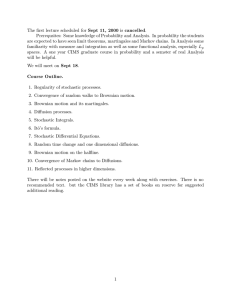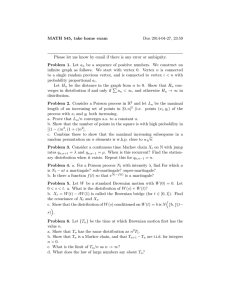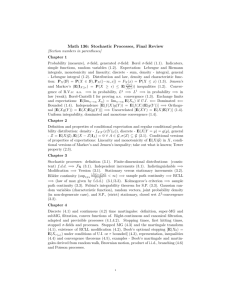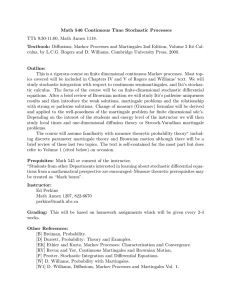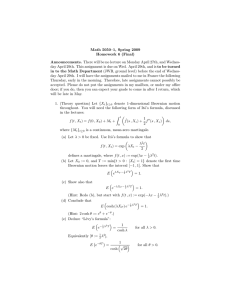3.3 Diffusions as Stocahstic Integrals
advertisement
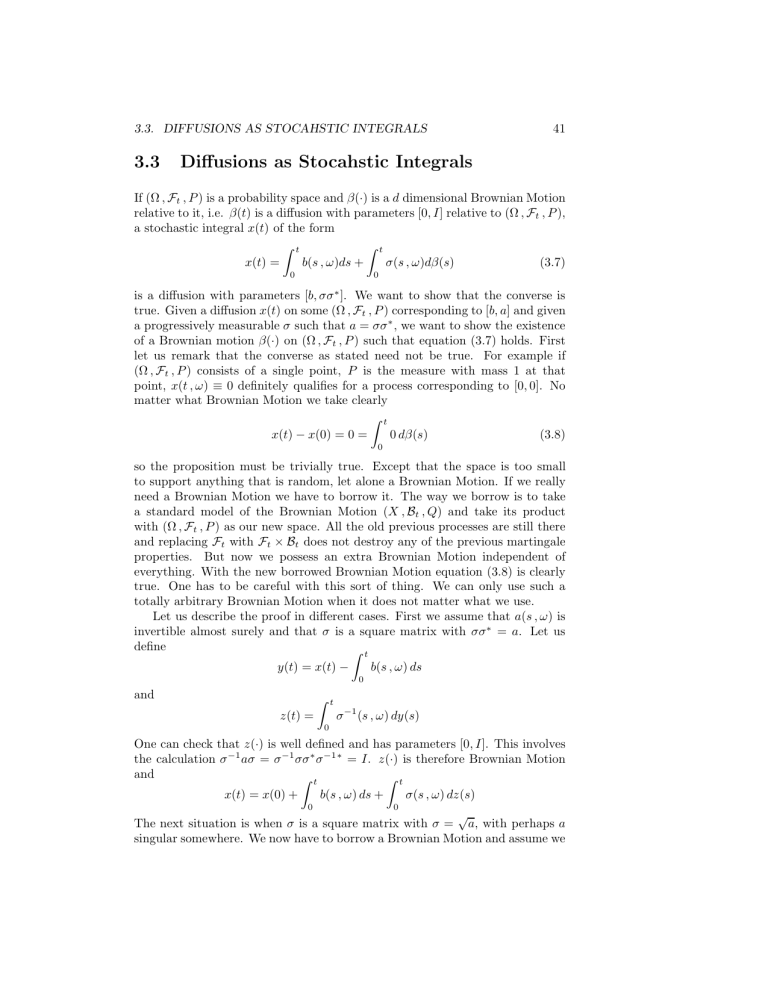
3.3. DIFFUSIONS AS STOCAHSTIC INTEGRALS
3.3
41
Diffusions as Stocahstic Integrals
If (Ω , Ft , P ) is a probability space and β(·) is a d dimensional Brownian Motion
relative to it, i.e. β(t) is a diffusion with parameters [0, I] relative to (Ω , Ft , P ),
a stochastic integral x(t) of the form
Z t
Z t
b(s , ω)ds +
σ(s , ω)dβ(s)
(3.7)
x(t) =
0
0
∗
is a diffusion with parameters [b, σσ ]. We want to show that the converse is
true. Given a diffusion x(t) on some (Ω , Ft , P ) corresponding to [b, a] and given
a progressively measurable σ such that a = σσ ∗ , we want to show the existence
of a Brownian motion β(·) on (Ω , Ft , P ) such that equation (3.7) holds. First
let us remark that the converse as stated need not be true. For example if
(Ω , Ft , P ) consists of a single point, P is the measure with mass 1 at that
point, x(t , ω) ≡ 0 definitely qualifies for a process corresponding to [0, 0]. No
matter what Brownian Motion we take clearly
Z t
0 dβ(s)
(3.8)
x(t) − x(0) = 0 =
0
so the proposition must be trivially true. Except that the space is too small
to support anything that is random, let alone a Brownian Motion. If we really
need a Brownian Motion we have to borrow it. The way we borrow is to take
a standard model of the Brownian Motion (X , Bt , Q) and take its product
with (Ω , Ft , P ) as our new space. All the old previous processes are still there
and replacing Ft with Ft × Bt does not destroy any of the previous martingale
properties. But now we possess an extra Brownian Motion independent of
everything. With the new borrowed Brownian Motion equation (3.8) is clearly
true. One has to be careful with this sort of thing. We can only use such a
totally arbitrary Brownian Motion when it does not matter what we use.
Let us describe the proof in different cases. First we assume that a(s , ω) is
invertible almost surely and that σ is a square matrix with σσ ∗ = a. Let us
define
Z t
b(s , ω) ds
y(t) = x(t) −
0
and
Z
z(t) =
t
σ −1 (s , ω) dy(s)
0
One can check that z(·) is well defined and has parameters [0, I]. This involves
the calculation σ −1 aσ = σ −1 σσ ∗ σ −1∗ = I. z(·) is therefore Brownian Motion
and
Z
Z
t
t
b(s , ω) ds +
x(t) = x(0) +
0
σ(s , ω) dz(s)
0
√
The next situation is when σ is a square matrix with σ = a, with perhaps a
singular somewhere. We now have to borrow a Brownian Motion and assume we
CHAPTER 3.
42
STOCHASTIC INTEGRATION
have done it. Let π(s , ω) be the orthogonal projection on to the range of a(s , ω).
The range of σ(s , ω) is the same as that of a(σ , ω) and we can construct the
inverse τ (s , ω) such that σ(s , ω)τ (s , ω) = τ (s , ω)σ(s , ω) = π(s , ω). We define
y(·) as before. But we define z(t) by
Z
Z
t
t
τ (s , ω) dy(s) +
z(t) =
0
0
[I − π(s , ω)]dβ(s)
where β is the borrowed d dimensional Brownian motion. It is only sparingly
used. We note that σ(s , ω), τ (s , ω), π(s , ω) and [I − π(s , ω)] are all symmetric.
τ (s , ω)a(s , ω)τ (s , ω) + [I − π(s , ω)][I − π(s , ω)]
= τ (s , ω)σ(s , ω)σ(s , ω)τ (s , ω) + [I − π(s , ω)][I − π(s , ω)]
= π(s , ω)π(s , ω) + [1 − π(s , ω)][1 − π(s , ω)] = I
So z is again Brownian Motion. We can now see that
Z
Z
t
t
b(s , ω)ds +
x(t) =
σ(s , ω) dz(s)
0
0
We need to show that
Z
t
0
[τ (s , ω)dz(s) − I dy(s)] = 0
A mean square calculation leads to showing
(τ (s , ω)σ(s , ω) − I)a(s , ω)(τ (s , ω)σ(s , ω) − I) + τ (s , ω)(I − π(s , ω))τ (s , ω) = 0
which is identically true.
We can do the same thing when σ(s , ω) is given as an n × k matrix with
σσ ∗ = a we now have to borrow a k dimensional Brownian Motion. We define
a k × n matrix τ (s , ω) by τ (s , ω) = σ ∗ (s , ω)a−1 (s , ω), where a−1 (s , ω) is such
that a(s , ω)a−1 (s , ω) = a−1 (s , ω)a(s , ω) = π(s , ω) with π(s , ω) as before. We
denote by π ∗ (s , ω) the orthogonal projection on to the range of σ ∗ (s , ω). Now
Z
Z
t
τ (s , ω)dy(s) +
z(t) =
0
0
t
(I − π(s , ω))dβ(s)
The rest of the calculations go as follows.
τ aτ ∗ + (I − π) = σ ∗ a−1 aa−1 σ + (I − π) = σ ∗ a−1 σ + (I − π) = I
and
[I − στ ]a[I − τ ∗ σ ∗ ] + τ [I − π]τ ∗ = 0
3.4. DIFFUSIONS AS MARKOV PROCESSES
3.4
43
Diffusions as Markov Processes
We will be intersted in defining Measures on the space Ω = C[[0, T ]; Rd ] with
the property that for some given x0 ∈ Rd
P [x(0) = x0 ] = 1
and
(3.9)
Z
Zf (t , ω) = f (x(t)) − f (x(0)) −
0
t
(Ls f )(x(s))ds
(3.10)
is a martingale with respect to (Ω , Ft , P ) for all smooth functions f , where
(Ls f )(x) =
X
1X
∂2f
∂f
ai,j (s , x)
(x) +
bi (s , x)
(x)
2 i,j
∂xi ∂xj
∂x
i
i
(3.11)
The data are the starting point x0 and the coefficients a = {ai,j (s , x)} and
b = {bi (s , x)}. We are seeking a solution P defined by these properties. In
the earlier notation a(s , ω) = a(s , x(s , ω)) and b(s , ω) = b(s , x(s , ω)). Instead
of starting at time 0 we could start at a different time s0 from the point x0
and then we would be seeking P , as a measure on the space Ω = C[[s0 , T ]; Rd ]
with analogous properties. We expect to show that under reasonable hypothese
on the coefficients a and b, for each s0 , x0 , Ps0 ,x0 exists and is unique. The
solutions {Ps0 ,x0 } will all be Markov Processes with continuous paths on Rd
with transition probabilities
p(s , x , t , A) = Ps,x [x(t) ∈ A]
satisfying the Chapman-Kolmogorov equations
Z
p(s , x , u , A) = p(s , x , t , dy)p(t , y , u , A)
for s0 ≤ s < t < u ≤ T . Moreover
Ps,x [x(t1 ) ∈ A1 , · · · , x(tn ) ∈ An ]
Z
Z
···
p(s, x, t1 , dy1 ) · · · p(tn−1 , yn−1 , tn , dyn )
=
A1
(3.12)
An
Our goal is to find reasonably general conditions that guarantee the existence
and uniqueness. We will then study properties of the solution Ps0 ,x0 and how
they are related to the properties of the coefficients.
3.5
Martingales and Conditioning.
Given Fs for some s ∈ [0, T ], we have the regular conditional probability distribution Qs ,ω = P |Ft which has the following properties. For each ω, Qs ,ω is a
probability measure on Ω and for each A, Qs ,ω (A) is Fs measurable. Moreover
Qs ,ω [ω 0 : x(t , ω 0 ) = x(t , ω) for 0 ≤ t ≤ s] = 1
CHAPTER 3.
44
STOCHASTIC INTEGRATION
Z
and
P (A) =
Qs ,ω (A)dP (ω)
for all A.Such a Q exists and is essentially unique, i.e any two versions agree for
almost all ω w.r.t P .
Lemma 3.6. If M (t) is a martingale relative to (Ω , Ft , P ) then for almost all
ω and times t ∈ [0, T ], M (t) is a martingale with respect to (Ω , Ft , Qs,ω ).
Proof. We need to check that if A ∈ Ft1 , and t2 > t1 ≥ s,
Z
Z
M (t2 )dQs,ω =
M (t1 )dQs,ω
A
A
for almost all ω. Since both sides are Fs measurable it suffices to check that
Z Z
Z Z
M (t2 )dQs,ω dP =
M (t1 )dQs,ω dP
B
A
B
A
From the properties of rcpd this reduces to
Z Z
Z Z
M (t2 )dQs,ω dP =
A∩B
or
M (t1 )dQs,ω dP
A∩B
Z
Z
M (t2 )dP =
A∩B
M (t1 )dP
A∩B
Since A ∩ B ∈ Ft1 this follows from the martingale property of M (t). Now all
that is left is some technical stuff involving sets of measure 0. As of now the
null set depends on t1 , t2 and the set A. We take a countable set of rationals for
t1 , t2 and a countable set of A0 s that generate the σ-field. One null set works
for these. Any thing that works for these works for every thing by the usual bag
of tricks. If we have a family Mα (t) of martingales indexed by α then the null
set now may depend on α. If we can find a countable set of α’s such that the
corresponding set of Mα (t)’s can approximate every Mα (t), we can get a single
null set to work for all the martingales. The family Zf (t) indexed by smooth
functions f is clearly such a family.
3.6
Conditioning and Stopping Times.
Lemma 3.7. Let τ be a stopping time relative to the family Ft of σ-fields. We
can apply the same reasoning to infer that for any martingale M (t) the property,
that it remains a martingale with respect to the r.c.p.d. Qτ ,ω of P given Fτ for
times t ≥ τ (ω), is valid for almost all ω w.r.t. P .
3.7. AN EASY EXAMPLE.
45
Proof. The proof again requires the verification for almost all ω of the relation
Z
Z
M (t2 )dQτ ,ω =
M (t1 )dQτ ,ω
A
A
on the set {ω : t2 ≥ t1 ≥ τ (ω)}. Given B ∈ Fτ such that B ⊂ {ω : τ (ω) ≤ t1 }
we need to check
Z Z
Z Z
M (t2 )dQτ ,ω dP =
M (t1 )dQτ ,ω dP
B
A
B
A
Since B ⊂ {ω : τ (ω) ≤ t1 } and B ∈ Fτ it follows from the definition of Fτ that
B ∈ Ft1 and it amounts to verifying
Z
Z
M (t2 )dP =
M (t1 )dP
A∩B
A∩B
which follows from the facts A ∩ B ∈ M (t1 ) and M (t) is a P -martingale. One
has to again do a song and dance regarding sets of measure zero. Ultimately,
this reduces to the question: is Fτ countably generated? The answer is yes, and
in fact, it is not hard to prove that
Fτ = σ {x(t ∧ τ (ω)) : t ≥ 0}
which is left as an exercise.
Let us suppose that we are given some coefficients a(t , x) and b(t , x). For each
(s, x) we can define the class Ms0 ,x0 as the set of solutions to the Martingale
Problem for [a, b], that start from the intial position x0 at time xo . A restatement
of the result described earlier is that the r.c.p.d. Qτ ,ω of P |Fτ is again in the
class Ms ,τ . In particular if there is a unique solution Ps ,τ to the martingale
problem, then the r.c.p.d. Qτ ,ω = Pτ,x(τ ). This implies that once we have
proved uniqueness, the solutions are all necessarily Markov and in fact strong
Markov.
3.7
An easy example.
In Rd , let us take a(t , x) = I and for [I, b(t , x)] let us try to construct a solution
to the martingale problem starting at (s0 , x0 ). For simplicity let us assume that
b(t , x) is bounded uniformly. We can check that the expression
Z t
Z
1 t
2
< b(s , x(s) , dx(s) > −
kb(s , x(s))k ds
Rt (ω) = exp
2 s0
s0
is a martingale with repect to (Ω , Fts0 , Qs0 ,x0 ), where Qs0 ,x0 is the d-dimensional
Brownian motion starting from x0 at time 0. The same is true of
Z t
Z
1 t
< θ + b(s , x(s)) , dx(s) > −
kθ + b(s , x(s))k2 ds
Rθ ,t (ω) = exp
2 s0
s0
CHAPTER 3.
46
STOCHASTIC INTEGRATION
for every θ ∈ Rd . We can write
Rθ ,t (ω) = Rt (ω)Zθ ,t (ω)
where
Zθ ,t (ω)
Z
t
= exp
s0
Z
< θ , dx(s) > −
t
s0
1
< θ , b(s , x(s)) > −
2
Z
t
2
kb(s , x(s))k ds
s0
We can define a measure Ps0 ,x0 such that for t ≥ s0
dPs0 ,x0
dQs0 ,x0
s
Ft 0
= Rt (ω)
Then clearly Ps0 ,x0 is a solution. Conversely if P is any solution, Q defined by
dQ = [Rt (ω)]−1 dP
on Fts0
is a solution for [I , 0] and is therefore the unique Brownian motion Qs0 ,x0 .
Therefore P = Ps0 ,x0 defined above. So in this case we do have existence and
uniqueness.
A second alternative is to try to solve the equation
Z t
b(s , y(s))ds
y(t) = x(t) +
s0
for t ≥ s0 and for Brownian paths x(t) that start from x0 at time s0 . If we
can prove existence and uniqueness, the solution will define a process which
solves the martingale problem. It is defined on perhaps a larger space but it
is easy enough to map the Wiener measure through y(·) and the transformed
measure is a candidate for the solution of the martingale problem. Since we
have uniquenes, this must coincide with the earlier construction. If b satisfies a
Lipshitz condition in x this can be carried out essentially by Picard iteration.
A third alternative is to try to solve the PDE
X
∂u
∂u 1
+ ∆+
bi (s , x)
=0
∂s
2
∂x
i
i
(3.13)
for s ≤ t with the boundary condition u(t , x) = f (x). The fundamental solution p(s , x , t , y) can be used as transition probabilities to construct a Markov
Process which again is our old P . To see this, we verify that if u is any solution
of equation (3.13) then u(t , x(t)) is a martingale with repect to any Ps0 ,x0 and
therefore
Z
u(s0 , x0 ) = f (y)p(s0 , x0 , t , y)dy = E Ps0 ,x0 f (x(t)
Since this is true for any f the fundamental solution is the same as the transition
probability of the alraedy constructed Markov Process.

